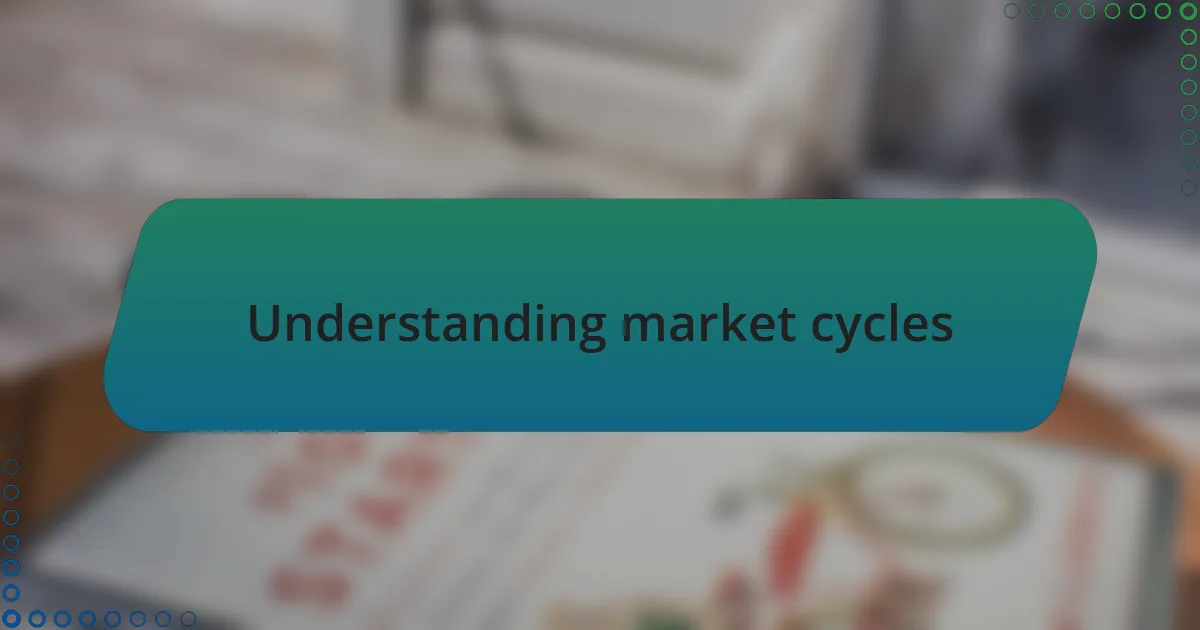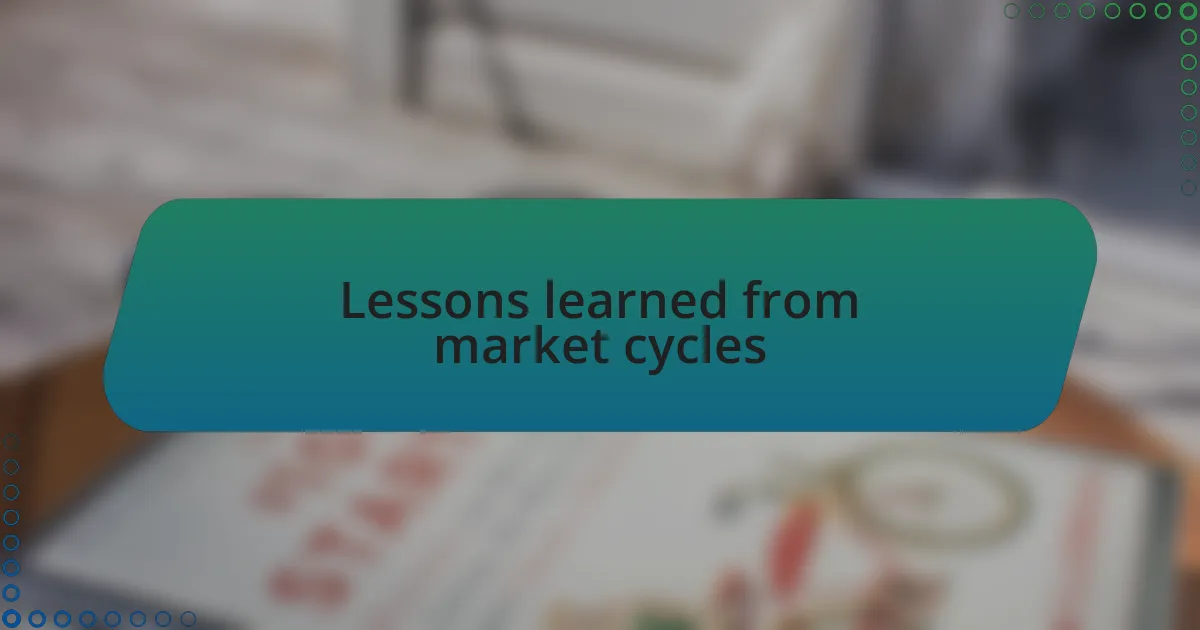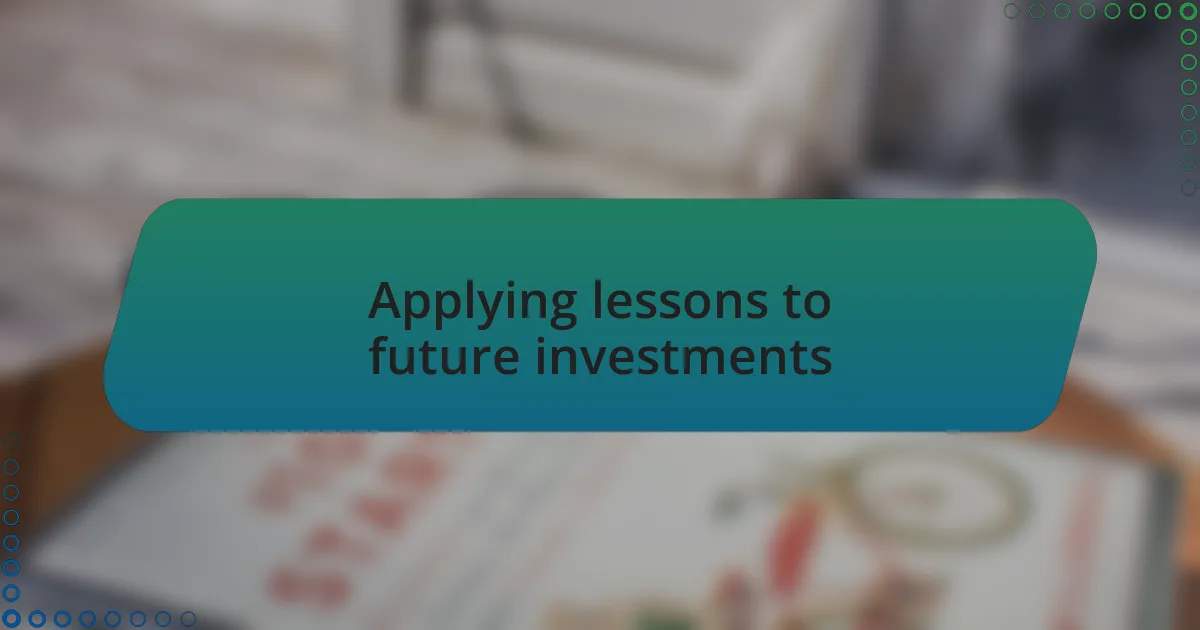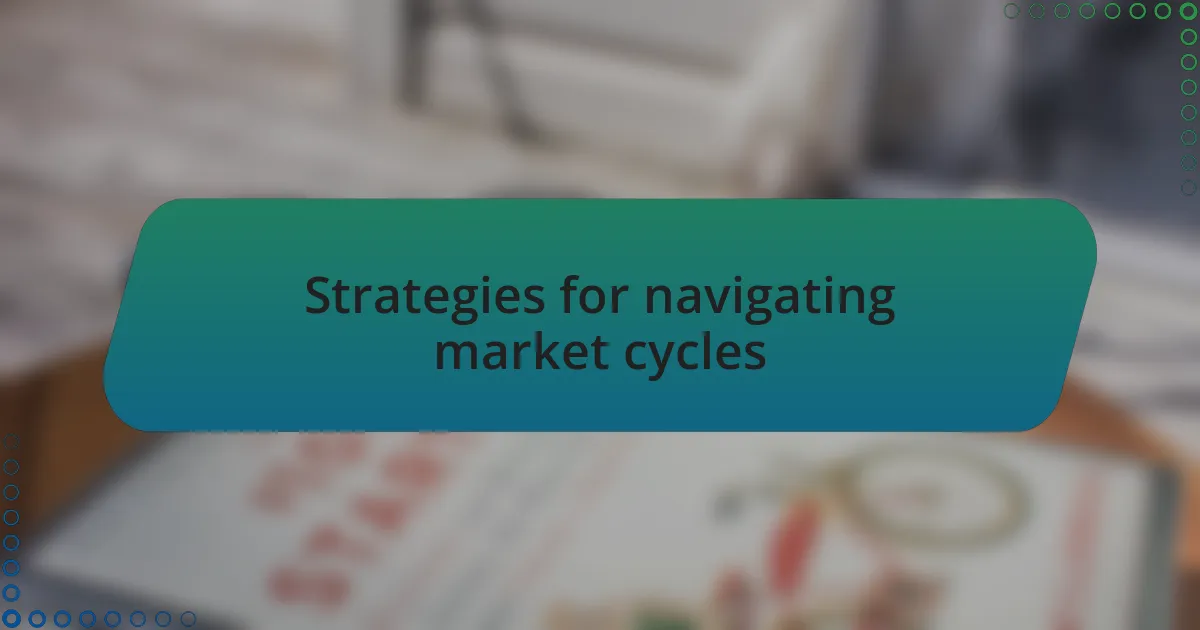Key takeaways:
- Market cycles consist of four phases: expansion, peak, contraction, and trough, each offering valuable lessons for investors.
- Diversification is essential to mitigate risks during downturns, as reliance on a single sector can lead to significant losses.
- Emotional balance and a proactive mindset are crucial for navigating market volatility and seizing opportunities.
- Flexibility in investment strategies, such as dollar-cost averaging and having clear rebalancing rules, can enhance long-term success.

Understanding market cycles
Market cycles are fascinating, and understanding them is crucial for any investor. I remember the thrill of riding out a bull market, where it seemed like every investment I made grew effortlessly. But the reality hit hard during the subsequent bear market, leaving me to ponder: how could something that felt so permanent turn so quickly?
Each market cycle—comprising expansion, peak, contraction, and trough—brings unique lessons. I learned to appreciate the small signs that indicate where we might be in the cycle. Reflecting on my early days, I recall dismissing economic indicators like interest rates, thinking they didn’t apply to my investments. Now, I see them as vital clues that help me navigate the economic landscape.
What truly resonates with me is the emotional roller coaster of investing during these cycles. I’ve felt the euphoria that comes with market highs and the despair during lows. It raises the question: how do we maintain our composure when the markets are volatile? For me, staying educated and remembering that these fluctuations are part of a larger rhythm has been key to maintaining my confidence and strategy through time.

Key phases of market cycles
The phases of market cycles are distinct yet interrelated, and each offers critical opportunities for reflection and growth as an investor. Early in my career, I often found myself caught off guard during the expansion phase, where optimism ran high and risk was easy to overlook. It’s like being swept up in a tidal wave; while exhilarating, it can easily lead to missteps if we forget to assess the undercurrents.
As the market reaches its peak, I remember feeling an almost intoxicating sense of confidence. But, looking back, this was the moment to sharpen my focus, rather than relax. I’ve learned that history can be a cruel teacher; the transition into the contraction phase is often swift, leaving even seasoned investors scrambling. How do we prepare for that inevitable downturn? For me, it means prioritizing a diversified portfolio and setting realistic expectations, allowing me to weather the storm when the tide inevitably turns.
During the trough phase, I’ve experienced significant emotional upheaval; the sense of loss can feel overwhelming. Yet, in these moments, I found immense value in resilience. I’ve come to see this phase not as a failure but as fertile ground for growth. Reflecting on prior downturns, I realized that the strategies I developed then have made me a more shrewd investor today. Isn’t it fascinating how discomfort often paves the way for deeper insights and opportunities?

Personal experiences with market cycles
There was a point in my journey when I underestimated the impact of market cycles entirely. I vividly recall investing heavily during a bullish spree without fully considering what could lie ahead. The euphoria around me was contagious, and I thought I was invincible, only to realize that complacency can turn into a harsh wake-up call when downturns hit unexpectedly.
During a particularly challenging contraction phase, I stumbled upon a valuable lesson: the importance of maintaining emotional balance. I remember grappling with anxiety every time I checked my portfolio, watching numbers drop as quickly as they had risen. It was during this tumultuous time that I learned to focus on my long-term goals instead of reacting impulsively, fostering a sense of calm that I had previously underestimated.
In the aftermath of that trough, I discovered that my perspective on risk had shifted dramatically. Rather than dreading market downturns, I started viewing them as opportunities to refine my investment strategies. It amazed me how resilience became my greatest asset, and I often ask myself, what would I have missed had I not embraced those harder lessons? It’s a powerful realization that every cycle, even the tougher ones, can lead to personal and financial growth if approached with the right mindset.

Lessons learned from market cycles
Navigating through various market cycles has taught me that diversification is not merely a strategy but a necessity. I remember during my early investments, I found myself heavily reliant on technology stocks. When that sector faced a downturn, I faced a significant loss, which made me question my approach. Looking back, I now see how spreading investments across different sectors can act as a safety net during volatile times.
Another lesson emerged when I experienced the excitement of chasing high returns. I vividly recall a friend who invested in a “hot” trend, only to watch his investment plummet. This taught me that while market trends can be tempting, it’s essential to conduct thorough research and understand the fundamentals of what you’re investing in. I often reflect on how important patience is in this industry; slow and steady wins the race.
Lastly, I’ve learned the power of staying informed and adaptable. During a recent downturn, I began to read various market analyses and engage in discussions with seasoned investors. This proactive approach not only bolstered my confidence but also allowed me to pivot strategies when needed. It leads me to ask, how can one truly succeed without being willing to evolve? Embracing change and learning from each cycle has become integral to my investment philosophy.

Applying lessons to future investments
Reflecting on my investment journey, I’ve come to appreciate the importance of timing. I recall a period when I held onto a stock long after it peaked because I was emotionally attached to my initial investment. That experience taught me that emotions can cloud judgment. How can we make wise decisions if we’re not willing to reassess and sometimes let go? I’ve learned that setting predetermined exit strategies based on analysis rather than feelings is crucial for not just success but also peace of mind.
Thinking back to the market downturn of a couple of years ago, I realized how crucial it is to have a proactive mindset. I remember discussing the situation with a mentor who advised me to look for undervalued stocks. That moment solidified my belief that downturns can present opportunities. Instead of being paralyzed by fear, what if we recalibrated our views and seized the moment? I started diversifying into sectors that seemed resilient, which not only mitigated potential losses but also positioned me for quicker gains.
I’ve found that networking with fellow investors can provide invaluable insights. I remember attending a local investment club where we shared strategies and experiences. Listening to stories of others—both their successes and their failures—opened my eyes to different perspectives I had overlooked. It’s fascinating to think: who can offer me wisdom that I haven’t encountered yet? By collaborating and sharing within a community, my approach became more well-rounded and informed, enriching my investment strategy in ways I hadn’t anticipated.

Strategies for navigating market cycles
Recognizing the patterns of market cycles has led me to embrace a strategy of flexibility. During one particularly tumultuous market phase, I was reminded of the importance of allocating resources based on current trends rather than past performance. I tried reallocating a portion of my portfolio towards growth sectors that were thriving, which felt both risky and invigorating. How many times do we cling to what was working before? By being open to change, I’ve been able to navigate volatility more effectively.
Another effective approach is dollar-cost averaging, which I adopted after experiencing significant market fluctuations. When prices were low, I kept investing steadily over time, which eased the anxiety of trying to time the market perfectly. Reflecting on that experience, I often wonder: how many investors miss opportunities by waiting for the “perfect” moment? This strategy allowed me to acquire more shares when prices were down, leading to a healthier long-term outlook and making the ride smoother.
Lastly, I’ve found that having a clear set of rules for rebalancing my portfolio is vital during unpredictable times. I remember nearly overlooking this until a market drop forced me to reassess my asset allocation. I questioned whether I was holding onto assets based on nostalgia rather than their actual performance. Creating a systematic schedule for evaluations not only keeps my portfolio aligned with my goals but also keeps emotional biases in check. Isn’t it fascinating how structured strategies can help us manage instinctual reactions?